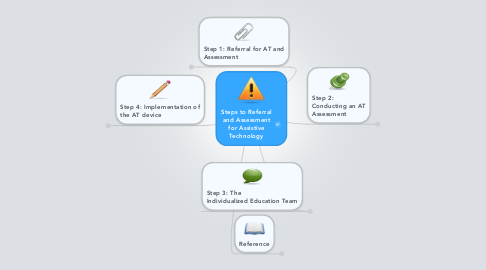Steps to Referral and Assessment for Assistive Technology
by Jessica Fazzolari

1. Step 1: Referral for AT and Assessment
1.1. "This is an initial referral, a referral of a transferring student, or a request for a student already receiving special education services. A family member, a referring agency, a physician, a teacher, or another school professional may make the referral (Beard 42). The team will want to organize and consider the following information": • Student data or personal information • Medical data for vital concerns • Vision and hearing reports • Information about any technology or equipment currently in use • Background information regarding any related services provided previously for the student (Beard 42-43)
2. Step 2: Conducting an AT Assessment
2.1. AT specialists may develop their own interview questions. These interviews can yield a wealth of useful information, including the following: • Family concerns and expectations • Perceived needs and abilities of the student • Academic expectations • Diagnostic information • Medical information (Beard 44) - The AT assessment includes several methods of obtaining formal and informal information required to create a plan tailored specifically to the child's needs and abilities
3. Step 3: The Individualized Education Team
3.1. The Individualized Education Team gathers to provide multidisciplinary required to create an Individualized Education Plan (IEP). The team will decide on the devices needs that would be best for the child's needs. The trial period takes place in the first 30 days to allow the parents, child and the IEP team to come up with the device that best suits the child's needs.
4. Step 4: Implementation of the AT device
4.1. Support is continually given to the student and the parents from the IEP team. This includes ongoing observation and monitoring. The special education teacher plays an important role. It up to the educator to make sure that the AT device is successful for the student.
5. Reference
5.1. Beard, L.A., Carpenter, L.B., & Johnston, L.B. (2011). Assistive technology: Access for all students (2nd ed.). Upper Saddle River, NJ: Pearson Education, Inc.


